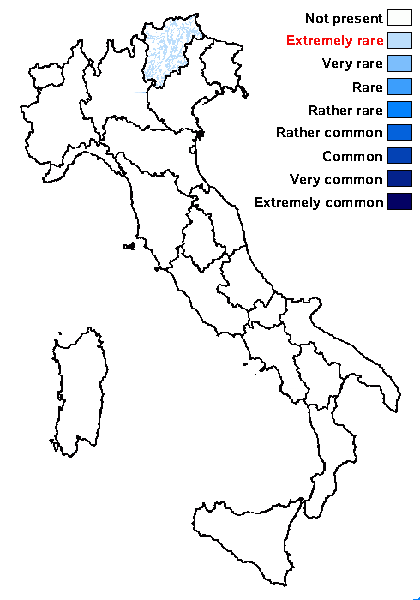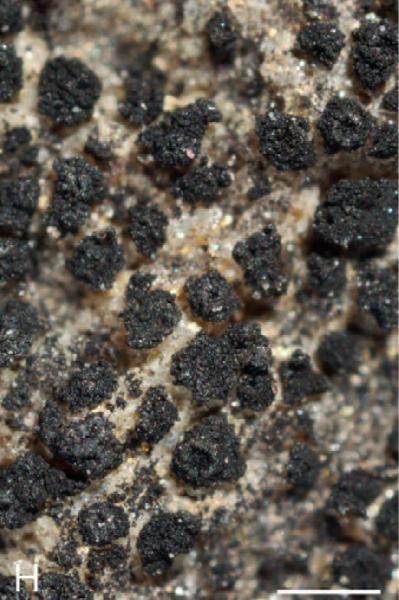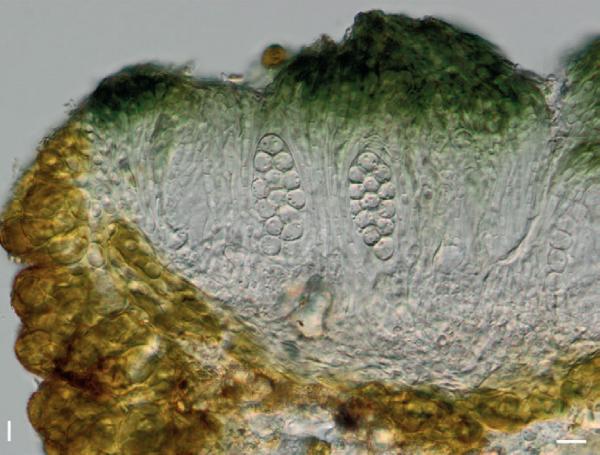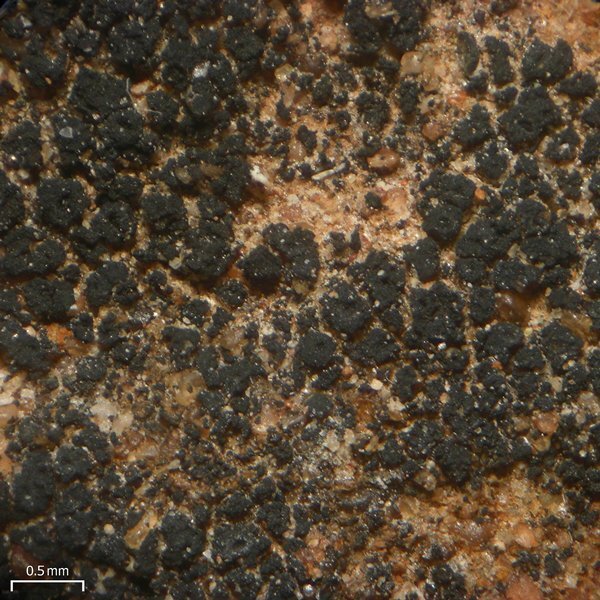Thelignya arnoldii (Frauenf.) M. Schultz & M. Prieto
Studies in Mycology, 109: , 624, 2024.. Basionym: Psorotichia arnoldii Frauenf. - in Arnold, Verh. K. K. zool.-bot. Ges. Wien, 14: 462, 1864.
Synonyms: Psorotichia taurica (Nyl.) Vain.; Psorotichia tiroliensis Zahlbr.
Distribution: N - TAA (Dalla Torre & Sarnthein 1902, Schultz 2014, Nascimbene & al. 2022).
Description: Thallus crustose, black to brown-black, subgelatinous when wet, granulose to minutely areolate, forming 1-3 cm wide, irregular patches, pseudoparenchymatous throughout. Areoles 0.15-0.5 mm across, up to 0.3 mm thick, the surface finely granulose. Apothecia formed from a spheroid tangle of generative hyphae with ascogones and trichogynes (no pycnoascocarps), at fist semi-immersed and punctiform, then sessile, up to 0.25 mm across, with a blackish, urceolate, sometimes umbonate disc and a prominent, persistent thalline margin. Proper exciple thin; epithecium blue green to emerald green, K-; hymenium colourless or greenish in upper part, 80-100 µm high, usually with central intrusions of sterile hyphae forming a small umbo, I-; paraphyses slender, septate; hypothecium colourless. Asci 16-spored, narrowly cylindrical-clavate, with a very thin wall disintegrating or opening by apical ruptures, without apical amyloid structures, Lichina-type. Ascospores 1-celled, hyaline, globose and 6-7 µm wide, or broadly ellipsoid and (5-)7-9(-10) x (3-)5-8 µm. Pycnidia immersed, broadly pyriform, (0.05-)0.1-0.125 mm across, unilocular or finally plurilocular. Conidia broadly ellipsoid, (2-)2.5-3.5 x 1.5-2 µm, produced terminally on simple conidiophores. Photobiont cyanobacterial (Rivulariaceae), filamentous, the tips of filaments tapered, basally often with heterocysts (but filaments often much contorted and split). Spot tests: all negative. Chemistry: without lichen substances. Note: a very poorly known species; ecological indicator values are tentative.
Growth form: Crustose
Substrata: rocks
Photobiont: cyanobacteria, filamentous (e.g. Nostoc, Scytonema)
Reproductive strategy: mainly sexual
On otherwise dry surfaces with short periods of water seepage after rain
Poorly known taxon in need of further study
Commonnes-rarity: (info)
Alpine belt: absent
Subalpine belt: absent
Oromediterranean belt: absent
Montane belt: extremely rare
Submediterranean belt: absent
Padanian area: absent
Humid submediterranean belt: absent
Humid mediterranean belt: absent
Dry mediterranean belt: absent

Predictive model

Source: Prieto M., Wedin M., Schultz M. 2024. Phylogeny, evolution and a re-classification of the Lichinomycetes. Studies in Mycology, 109: 595-655. - CC BY-NC-ND
Thelignya arnoldii, thallus crustose with sessile apothecia, discs black (Arnold, W1913-
5405, holotype). Scale bar: 0.5 mm

Source: Prieto M., Wedin M., Schultz M. 2024. Phylogeny, evolution and a re-classification of the Lichinomycetes. Studies in Mycology, 109: 595-655. - CC BY-NC-ND
Thelignya arnoldii, Flat thallus areoles with semi immersed to sessile apothecia and black discs (Schultz 08933). Scale bar: 0.5 mm

Source: Prieto M., Wedin M., Schultz M. 2024. Phylogeny, evolution and a re-classification of the Lichinomycetes. Studies in Mycology, 109: 595-655. - CC BY-NC-ND
Thelignya arnoldii, Hymenium with polysporous asci, upper
part of proper exciple and central umbo distinctly greenish (Schultz 08933). Scale bar: 10 µm
Growth form: Crustose
Substrata: rocks
Photobiont: cyanobacteria, filamentous (e.g. Nostoc, Scytonema)
Reproductive strategy: mainly sexual
On otherwise dry surfaces with short periods of water seepage after rain
Poorly known taxon in need of further study
Commonnes-rarity: (info)
Alpine belt: absent
Subalpine belt: absent
Oromediterranean belt: absent
Montane belt: extremely rare
Submediterranean belt: absent
Padanian area: absent
Humid submediterranean belt: absent
Humid mediterranean belt: absent
Dry mediterranean belt: absent

Predictive model

Source: Prieto M., Wedin M., Schultz M. 2024. Phylogeny, evolution and a re-classification of the Lichinomycetes. Studies in Mycology, 109: 595-655. - CC BY-NC-ND
Thelignya arnoldii, thallus crustose with sessile apothecia, discs black (Arnold, W1913- 5405, holotype). Scale bar: 0.5 mm

Source: Prieto M., Wedin M., Schultz M. 2024. Phylogeny, evolution and a re-classification of the Lichinomycetes. Studies in Mycology, 109: 595-655. - CC BY-NC-ND
Thelignya arnoldii, Flat thallus areoles with semi immersed to sessile apothecia and black discs (Schultz 08933). Scale bar: 0.5 mm

 DOLICHENS
DOLICHENS


